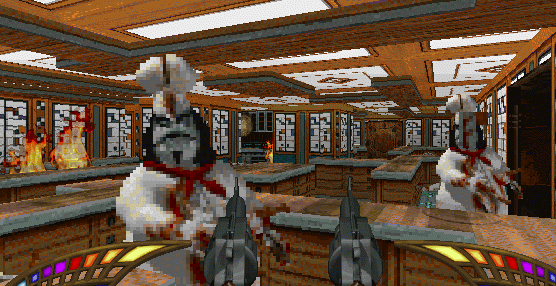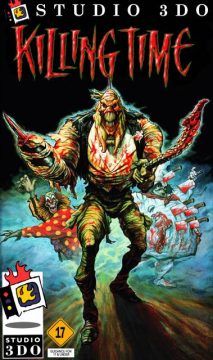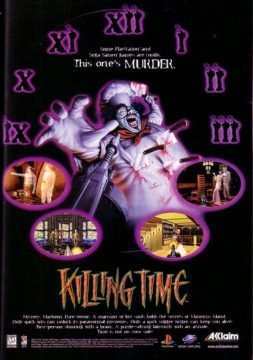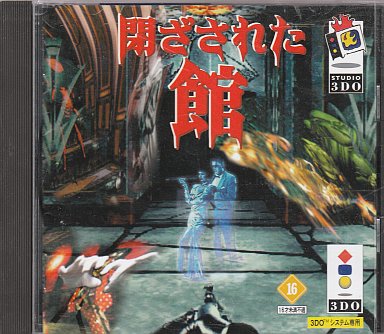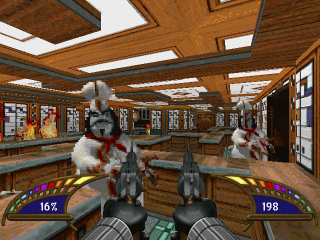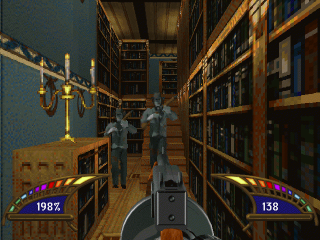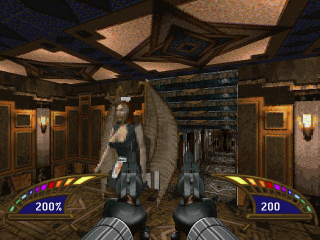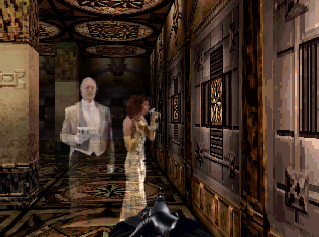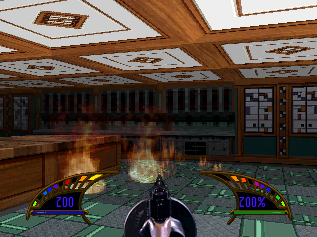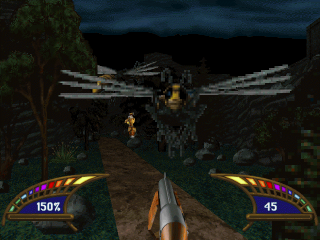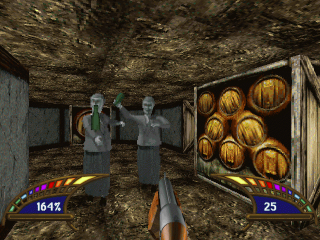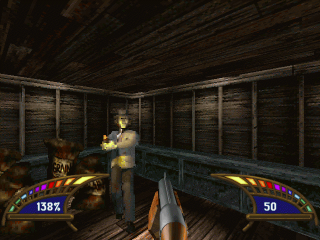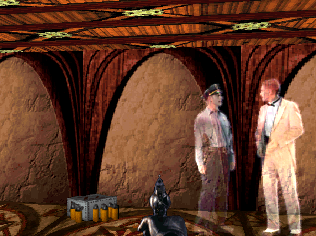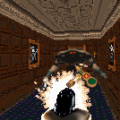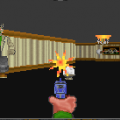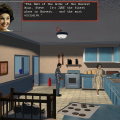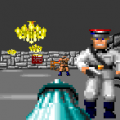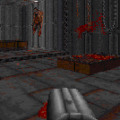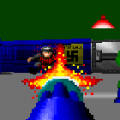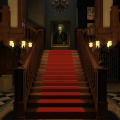An Egyptology professor, Dr. Hargrove, discovered an ancient water clock in the tomb of the pharaoh Ramses. The clock supposedly had the ability to grant everlasting life to its owner, but it mysteriously disappeared after the exhibition’s patron – heiress Tess Conway – visited the digging site. Tess was obsessed with the occult and wanted to give immortality a shot, so she’s suspected to have taken the clock back to her estate on Matinicus Island just off the coast of Maine. There Tess had nightly parties with her society friends, including but not limited to shady fellas like Duncan DeVries, a booze and gun smuggler from Chicago. On the night of the summer solstice of 1932, Tess and her guests vanished without a trace. You’ve decided to investigate the mystery, but you’re alone because you didn’t have any friends stupid enough to go with you. Fortunately you came with your trusty .45 revolver. The fun starts when you enter the courtyard and realize your watch has stopped…
Killing Time was released in 1995 for the 3DO Multiplayer System, and met with lukewarm reception, which is tragic because in many subtle ways it’s unlike any other first person shooter. In fact, it’s different and innovative enough that it ought to have been as much a landmark title as Quake and Duke Nukem, but its major shortcomings – no multiplayer, clunky mechanics, and being made for a system nobody could afford or cared for – ultimately kept it out of the spotlight.
The ultimate goal of Killing Time is to find Tess Conway’s water clock and destroy it, freeing the island from its eternal time flux and allowing its inhabitants to rest (and you to escape). The Conway Estate is a labyrinth of corridors and secrets, and you have to traverse every inch of it to complete your quest, all whilst shooting monsters Doom-style.
The Estate is a complex collection of mazes with different themes: kitchen, garden, and wine cellar to name a few. It’s almost like Wolfenstein 3D in a haunted mansion, though with Doom-like staircases and bridges in certain parts. There is an overhead map to aid you, though. In the mansion’s hallways and chambers, secrets and puzzles abound: from caches of ammo and health hidden behind wall-panels, to teleport puzzles that will have you tearing your hair out.
This is where the HUD – a pair of golden wings straddling the screen – comes in handy, and knowing how to read it is important. The left wing displays the current weapon’s ammo stock. Along the top are colored gems which represent the keys you possess – keys for the many, many locked doors all over Matinicus Isle. The right wing displays your remaining health, and its colored gems represent the winged vessels you’ve acquired: when you’ve used up a vessel’s power – invulnerability, 8x damage, or revealing all map secrets to name a few – its gem will go dark. The gem of an active vessel blinks to let you know it’s still got some juice left.
So how do you go about breaking an Egyptian relic? By reassembling a dismembered heiress, whose body parts reside in a dozen Winged Vessels. These are naturally scattered all over the game, and without them you can’t enter the attic where the water clock – and your final challenge – awaits.
And no shooter would be complete without a cast of creepy monsters, and some of Killing Time‘s critters are as creepy as they come. Others are so outrageous they’ll make you laugh out loud – the Zombie Bootlegger and Two-Headed Attack Poodle are hilarious – but don’t get careless around any of them, especially on higher difficulty settings when a couple of attacks are enough to drop you into the Conway crypt. Partly due to luck and partly to accuracy, there’s always the possibility a monster will go down with a single shot. It’s essentially like a free bonus kill that saves you ammo.
Not all of Tess’ guests became hideous undead aberrations: some turned into restless spirits cursed to relive their final moments for all eternity. As you explore the Conway Estate you’ll come across blue apparitions of Tess indicating where an important scene took place. Walk up to it and watch the ghosts of Tess and her friends reenact past conversations. Sometimes they give you interesting tidbits about the people that died in the mansion; sometimes they give you clues that help you in your quest.
The ghosts are the most innovative part of Killing Time by far: rather than interrupting the gameplay with a full-motion video sequence to develop the plot, Killing Time‘s cutscenes play out inside the game world. Already seen a scene? Just walk away and it vanishes. Miss an important detail? You can always go watch it again. By not pulling you out of the game world to tell the story, this feature really adds to the haunted house atmosphere and makes Killing Time truly unique in a genre full of copycats. And it’s most refreshing in this age where video games feature more movies to watch than levels to play.
The actors are great – much better than your standard fare from the FMV-era, though still delightfully melodramatic (they had to be, what with the low resolutions of the period). Everyone in the cast is memorable for the right reasons (i.e. not because they’re laughably bad). Robert is a textbook butler. Byron is a superb sniveling scientist. Duncan acts so big for being so small-time it’s easy to hate him. Tess Conway is particularly diabolical and a true femme fatale.
In the hopes of getting all the use they could out of their resources, 3DO had Mac-specialized company Logicware remake Killing Time with new maps and graphics, and released it in 1996 for the PC and Macintosh as a completely new game (it was also announced for PlayStation and Saturn, but those versions were never released), but again failed to achieve anything more than mild cult status, and even that is debatable. In the remake, the Estate is more true-to-life, if still a bit labyrinthine: there are thick forests and hunting lodges and a lighthouse. The island gives the impression of being an actual island, only the map doesn’t zoom out far enough to be useful. These versions also don’t have the random one-shot kill feature, which is too bad – especially since most of the monsters here have so much health it renders half your arsenal useless. Whatever version of Killing Time you play, you only get one life: die and it’s back to the jazzy title menu. You remembered to save your progress, though…right?
It’s easy to see Killing Time‘s flaws. Your turn speed in the 3DO version is erratic, making it tough to aim when it counts. The action tends to fall on the slow side, coming nowhere near the terror and panic of Doom or Quake. It was made for a $600+ system lacking in decent games, which killed its exposure. The original’s levels are confusing mazes. The remake’s levels are claustrophobic: you’re always bumping into walls, making it tough to avoid enemy fire. The original only has five guns; the remake has seven, but only three are useful. Worst of all, the mid-nineties was the Dawn of Deathmatch, and Killing Time had no multiplayer capability.
Still, it’s tough not to like it anyway. What really sells this game is the story, design, and atmosphere; and what sells that is the attention to detail. Everything is there for a reason. The ammo pickups are all over the island because Duncan ran out of storage space. The storeroom is on fire because the thugs moving Duncan’s arsenal had a smoke break next to a volatile container (implied by a ghost scene and the skeletal nicotine addicts). You need an RSVP to enter the mansion because everyone died during a party. All the monsters have their origins in the mansion as guests, pests, or Egyptian treasures. Even the dates and implied events in the manual suggest a vast history that gives the Conway Estate and its inhabitants an incredible amount of depth and personality: more than the average shooter ever had. It’s a shame Killing Time never really had its time in the spotlight.
Links:
The Conway Estate The only fansite for Killing Time, by the author.
Official Video Preview
